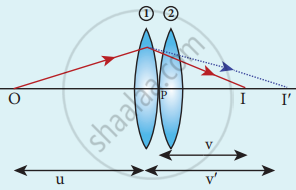Advertisements
Advertisements
प्रश्न
Derive the equation for effective focal length for lenses in contact.
उत्तर

Lenses in contact
- Two lenses (1) and (2) having focal length are placed coaxially in contact.
- Lens equation for first equation be
`1/"v'" - 1/"u" = 1/"f"_1` - Lens equation for the second lens be
`1/"v" − 1/"v′" = 1/"f"_2` - Adding the above equation
`1/"v" - 1/"u" = 1/"f"_1 + 1/"f"_2` - If the combinations acts as single lens then,
`1/"v" - 1/"u" = 1/"f"` - On comparing,
`1/"F" = 1/"f"_1 + 1/"f"_2`
∴ For any number of lens in contact
`1/"f"_1 + 1/"f"_2 + 1/"f"_3 + ....`
APPEARS IN
संबंधित प्रश्न
An object is placed in front of a convex mirror of focal length of f and the maximum and minimum distance of an object from the mirror such that the image formed is real and magnified.
The radius of curvature of curved surface at a thin planoconvex lens is 10 cm and the refractive index is 1.5. If the plane surface is silvered, then the focal length will be.
What are primary focus and secondary focus of convex lens?
What are the sign conventions followed for lenses?
Arrive at lens equation from lens maker’s formula.
Obtain the equation for lateral magnification for thin lens.
What is power of a lens?
Derive the equation for effective focal length for lenses in out of contact.
A thin converging glass lens made of glass with refractive index 1.5 has a power of + 5.0 D. When this lens is immersed in a liquid of refractive index n, it acts as a divergent lens of focal length 100 cm. What must be the value of n?
Find the ratio of the intensities of lights with wavelengths 500 nm and 300 nm which undergo Rayleigh scattering.
